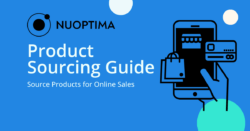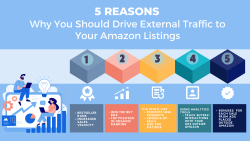Many advertising platforms offer in-depth analytics and insights, but Amazon stands out with the most extensive and granular consumer data.
With this amount of data, advertisers can get precise and actionable insights to optimize their targeting and increase sales.
However, with rising privacy concerns from users who are constantly declining third-party cookies, it is not easy to get access to user data. Amazon has made it possible to access large volumes of data without compromising the customer’s privacy or experience with the Amazon Marketing Cloud.
In this article, you will learn more about Amazon Marketing Cloud (AMC), how it works, and why you should use it if you are an ecommerce business owner or marketer.
What Is Amazon AMC?
Amazon Marketing Cloud (AMC) is a secure, privacy-focused analytics and measurement platform launched by Amazon Advertising in 2021.
AMC is a cloud-based platform built on Amazon Web Services (AWS) that provides advertisers with a flexible environment for customizable reporting using event-level data across multiple datasets. This includes both advertiser’s datasets and Amazon Advertising data, offering a more comprehensive view of campaign performance.
Amazon Marketing Cloud enables comprehensive analysis of advertising metrics, customer behavior, audience engagement, and campaign performance through aggregated reports, providing detailed insights while preserving user privacy.
Here is how it works in a nutshell:
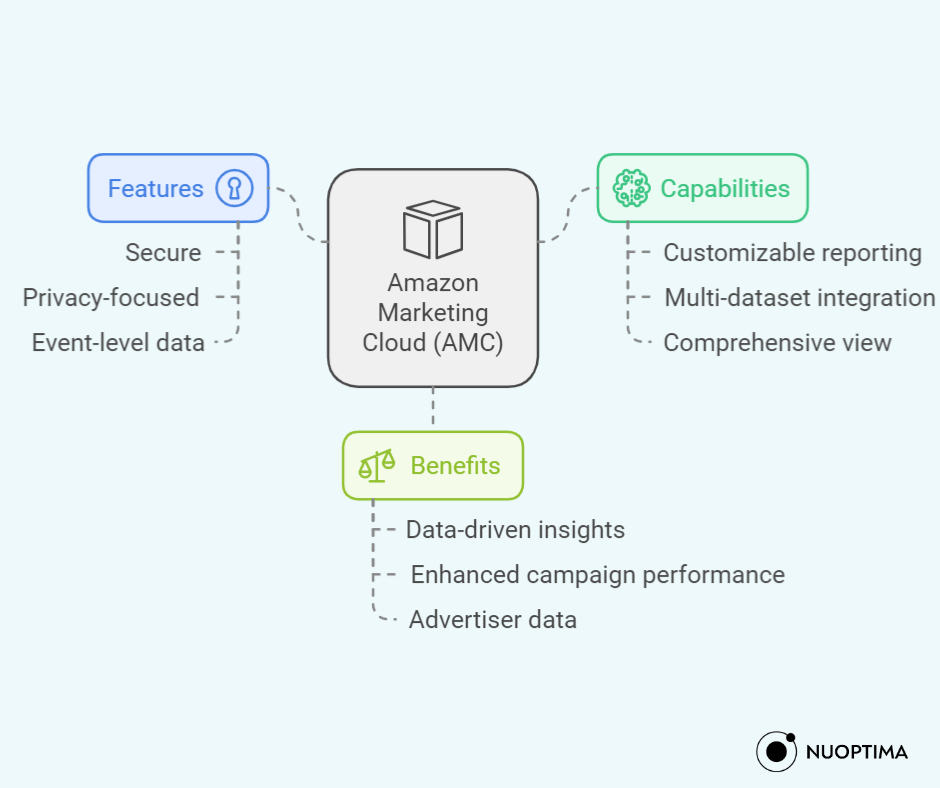
What can I do with Amazon Marketing Cloud?
In this section, you’ll learn more about the benefits and use cases for Amazon Marketing Cloud:
Access Detailed Ad Data
With AMC, you can access granular event-level ad data, such as which ads your shoppers viewed, clicked on and converted, with insight into how different components of your ads influenced their journey to conversion.
Types of granular data available:
| Type | Example |
| Ad Exposure Data | Impression timestampsAd format (e.g., Sponsored Products, Sponsored Brands, Display ads)Placement details (e.g., top of search, product detail pages) |
| Click Data | Click timestampsAd type clickedDevice used for clicking (desktop, mobile, tablet) |
| Conversion Data | Purchase timestampsProducts purchased (ASINs)Order value |
| Ad Component Data | Keywords triggered (for search ads)Creative variations viewed (for display ads)Video completion rates (for video ads |
For example, your data shows that customers who are exposed to both video ads on Amazon’s streaming TV and Sponsored Products ads have a 40% higher conversion rate than those who only see Sponsored Products ads.
This granular view across campaigns helps in developing more effective multi-channel strategies.
Explore Multi-Touch Attribution Models
AMC determines which efforts are contributing to your final conversions by accurately distributing credits among different ad touchpoints. With these models, you can properly value upper-funnel activities that may not directly lead to conversions but play a crucial role in the customer journey.
For example, a customer first views a sponsored brand ad for your product, then sees an Amazon DSP retargeting display, and finally converts by clicking on another sponsored product ad.
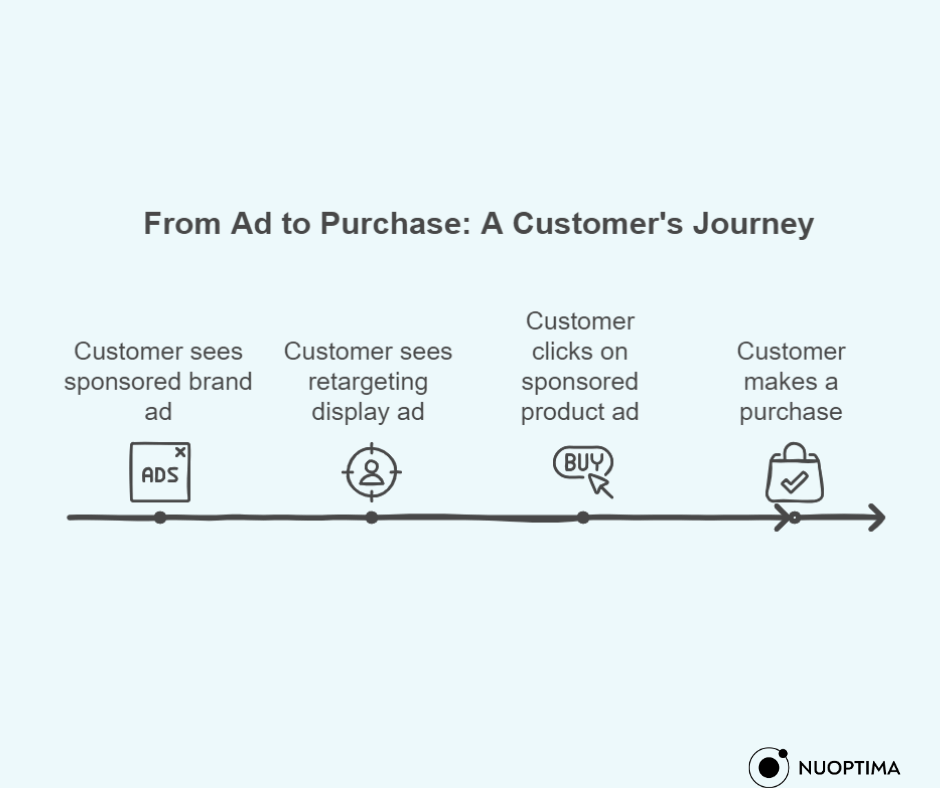
All these ad types influence the customer and not just the final touch point since you have the opportunity to see how different channels (e.g., Sponsored Products and DSP) work together to drive conversions directly.
Based on these insights, you can allocate the budget more effectively across different ad types and campaigns based on their true contribution to conversions.
Get Path to Conversion Insights
Every customer journey is different, with AMC, you can learn more about your audience in terms of audience attributes and the composition of your audience. You can see how long it takes for your shopper to make a purchase and the sequence of ad touchpoints they’ve encountered in their journey.
These insights precisely tell you how to navigate your ad strategy and get more customers.
Test Your Media Mix
If you are using different advertising platforms, with the Amazon Marketing Cloud, you get insights into how much each of them contributes to your final sales. AMC measures true incrementality and thus helps you optimize your PPC budget for the best results.
5 Top Features of Amazon Marketing Cloud
Amazon Marketing Cloud has an extensive list of features and customization options, but here is what really sets this platform apart from other ad analytics tools:
1. Comprehensive Reporting Capabilities with SQL
AMC offers powerful reporting tools driven by SQL so advertisers can dive deep into their campaign data. With these features, you can create custom analytics tailored to your specific needs.
For example, you might analyze the performance of a cross-channel campaign that includes Amazon DSP display ads, Sponsored Products, and video advertisements.
The platform allows for sophisticated path-to-conversion analysis using various attribution models. You could, for instance, compare the effectiveness of a last-touch attribution model against a linear model to understand how different touchpoints contribute to conversions.
This flexibility in reporting extends beyond standard Amazon DSP offerings, allowing you to generate bespoke reports that align with your unique KPIs and business objectives. AMC’s custom attribution analysis feature is particularly valuable for assessing the impact of different media channels.
For example, you could analyze how exposure to an Amazon DSP video ad influences subsequent engagement with your Sponsored Products, providing insights into the synergies between your advertising efforts.
2. Amazon Audiences
The Amazon Audiences feature in AMC uses SQL queries to create highly targeted custom audiences. This functionality taps into a rich array of signals from Sponsored Ads, Amazon DSP ads, and Amazon Shopping Insights. For instance, you could create an audience segment of customers who have viewed your products multiple times in the past week but haven’t made a purchase, ideal for a remarketing campaign.
One of the key strengths of this feature is the ability to set the frequency of audience refresh. This ensures your targeting remains up-to-date and relevant. You might, for example, set a daily refresh for a time-sensitive promotion or a weekly refresh for a broader brand awareness campaign.
The versatility of audience creation in AMC supports various campaign types across the marketing funnel. You could build separate audiences for awareness (e.g., users who haven’t interacted with your brand), consideration (e.g., users who have viewed your products), conversion (e.g., users who have added products to cart but not purchased), and loyalty (e.g., repeat customers) campaigns.
These extensive segmentation options make AMC an ideal platform to work with if your audience consists of different types, geolocations, etc.
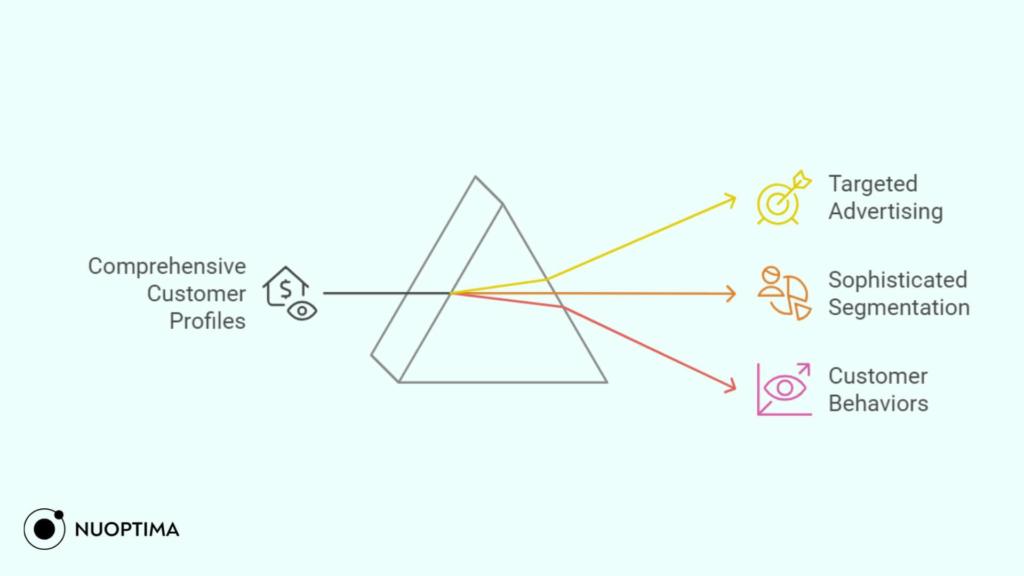
3. CDP Integration
AMC’s CDP integration capability significantly helps to create comprehensive customer profiles. By anonymously connecting data from your Customer Data Platform with AMC’s anonymized shopper information, you can gain a more holistic view of your customer’s behaviors and preferences.
This integration is compatible with major CDP providers such as Adobe, Salesforce, and Tealium. You can incorporate first-party data from various sources, including your website, CRM, or other internal systems.
For example, you could combine offline purchase history from your CRM with online browsing behavior on Amazon to create more targeted and personalized advertising campaigns.
The CDP integration opens up possibilities for sophisticated segmentation and targeting. You might, for instance, create a segment of customers who have high lifetime value in your CRM data and have also shown recent interest in your products on Amazon, so you can tailor your advertising approach for these valuable customers.
4. Sandboxing
The sandboxing feature in AMC provides a safe environment for learning, experimentation, and innovation. This controlled space uses simulated data that closely mimics real information, so users can practice and refine their AMC skills without affecting live campaigns.
Sandboxing is particularly useful for hands-on learning and query refinement. For example, a new team member could experiment with complex SQL queries to analyze customer behavior patterns or test different audience segmentation strategies without any risk to actual campaign performance.
This feature is a helping hand for software development trials with AMC. If you’re building custom tools or integrations to work with AMC data, the sandbox environment provides a realistic testing ground to ensure everything functions correctly before deployment in a live setting.
The sandbox environment is a perfect playground for larger marketing teams to explore their ideas, collaborate, test and refine.
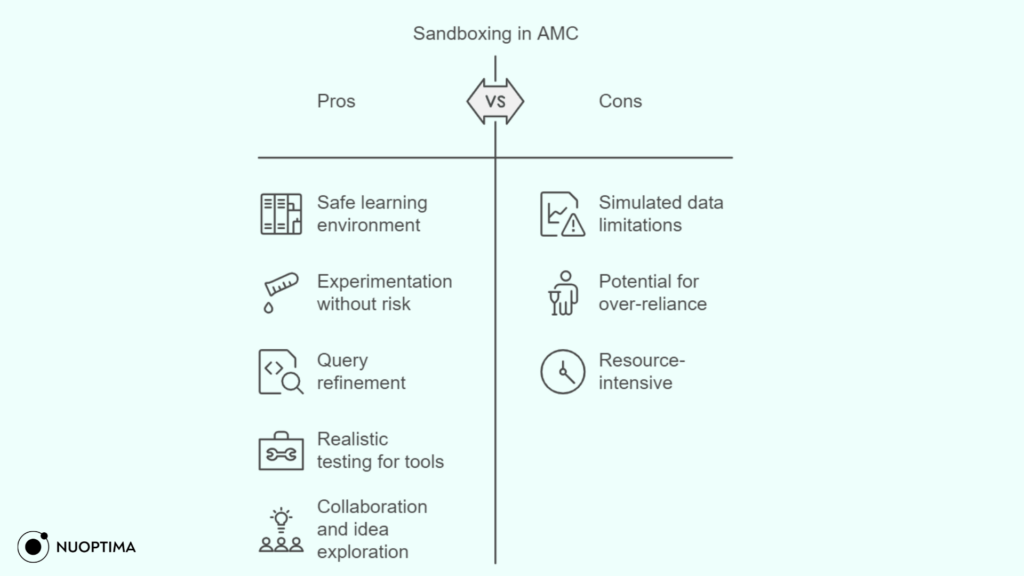
5. AMC Premium Features
At the beginning of 2024, AMC announced premium features (beta version) that didn’t have a fixed pricing but differed based on the user and their AMC account.
However, in June 2024, Alan Lewis announced that these features would be available for free (for all AMC users) until the end of 2024.
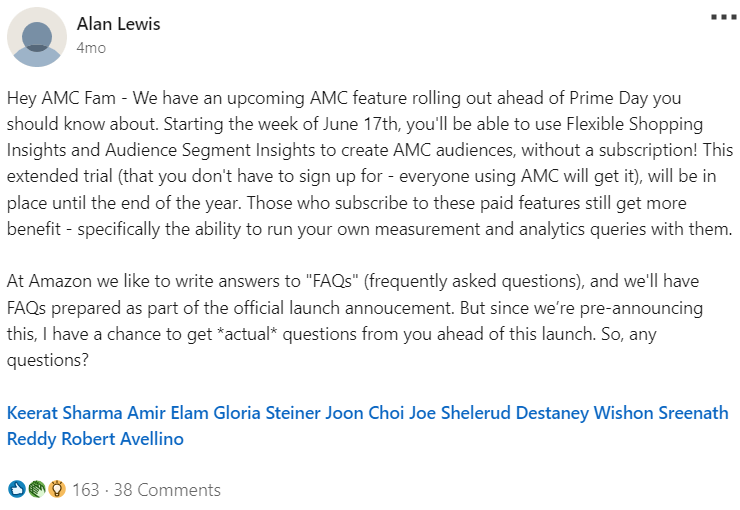
The premium features are called “Flexible Shopping Insights” and “Audience Segment Insights”. With these features, you get even more details, such as data on “added to gift list”, “product detail page view”, and “customer review page visits”, so you have proven data to back up changes in different aspects of your ecommerce store.
These insights influence your marketing, product, content writing, Amazon PPC keyword research and many more aspects that are often overlooked but have a clear effect on your customer experience or conversions.
With AMC Premium, you can gain deeper insights into brand engagement and shopping trends. For instance, you could analyze metrics such as total browse time, add-to-cart events, product detail page views, and non-ad attributed purchases. This comprehensive view allows you to understand how customers interact with your brand on Amazon, both through ads and organic discovery.
Find out more about our Amazon SEO strategies.
These insights can be invaluable for strategic decision-making. For example, you might discover that a particular product category has high organic visibility but low ad-driven sales, suggesting an opportunity to reallocate your advertising budget.
Another common situation is that you might identify products with high add-to-cart rates but low purchase rates, indicating a need for price optimization or improved product descriptions.
With these premium features, AMC has become the #1 platform for customer insights and ad analytics since it is highly customizable, has unique features and offers access to large volumes of data.
Still, not everyone can use their massive database and unique insights, here is what you need to tick off to join the “AMC club”:
How to Set Up AMC?
To be able to set up AMC, you need to have an Amazon DSP account, and file a request. Here are the main requirements for using AMC:
- An executed Amazon DSP Master Service Agreement
- An Amazon Web Services (AWS) account
- You’ve run campaigns on DSP in the last 28 days at least
- You (or your team member) is familiar with SQL database language
- You are based in one of the 17 countries * where AMC is available
*the United States, Canada, Mexico, Brazil, Germany, Spain, France, Italy, the Netherlands, Sweden, the United Kingdom, Saudi Arabia, the United Arab Emirates, Australia, India, Japan, and Singapore.
If your business meets these requirements, you need to fill out a registration form with insights on your business and Amazon Advertising account. Once you submit your information, the AMC team will verify and contact you within 3–5 business days to set you up.
Do you really need AMC if you use Amazon DSP reporting? Well, if you have a lot of campaigns, a low ROAS (return on ad spend) and work with multiple channels, you may benefit from using AMC.
AMC has more detailed and customizable reports when compared to classic DSP reporting, however, it can be complex at first if you aren’t used to the basic DSP setting.
Keep in mind that setting up an Amazon Marketing Cloud account is just the beginning. Analyzing and optimizing your marketing strategy are steps that lead to more sales and a better conversion rate.
With the help of ad experts and our Amazon PPC services, you can forget about AMC and just focus on the final reports and results we send you.
Conclusion
Amazon Marketing Cloud (AMC) stands out as one of the most comprehensive ad analytics tools, offering a range of benefits, use cases, and features that answer to the evolving needs and demands of e-commerce business owners and marketers.
At its core, AMC provides detailed cross-channel insights, enabling advertisers to gain a holistic view of their marketing efforts across various Amazon advertising products. This is achieved while maintaining strict adherence to privacy regulations, as AMC operates as a secure, cloud-based environment where data is aggregated and pseudonymized based on a hundred users.
Marketers use the platform for a variety of use cases, including detailed customer journey analysis, sophisticated attribution modeling, audience overlap studies and frequency optimization.
These use cases are backed by AMC’s customizable reporting features and its SQL-based query interface, which allows for tailored analyses that go beyond standard reporting templates offered by DSP reporting and other platforms.
The platform’s integration with multiple Amazon advertising products further makes it more valuable since it encourages advertisers to consolidate data from various sources for more comprehensive insights.
This consolidated view, combined with AMC’s advanced analytics capabilities, encourages marketers to make more informed decisions and optimize their strategies across all their channels. Without this data a lot of budget is wasted on testing and validating campaigns and channels.
If you don’t want to spray and pray and figure out Amazon advertising on your own, NUOPTIMA will be your helping hand. We got ad experts and proven strategies that brought our clients amazing results.
Speak to our Amazon DSP experts at NUOPTIMA and find out more about our Amazon SEO services, how you can set up your AMC, maximize your ROI, reach Amazon shoppers effectively, and optimize your Amazon advertising strategy for the best results.
A proven Amazon marketing strategy is just a call away.
FAQ
Amazon Marketing Cloud (AMC) is a secure, privacy-safe analytics platform. It allows advertisers to analyze aggregated, pseudonymized data from various Amazon ad campaigns and products. AMC helps marketers gain insights into customer journeys, optimize ad strategies, and measure campaign effectiveness across different touchpoints.
Amazon Marketing Cloud was officially launched in 2021. However, it was initially available to a limited number of advertisers as part of a beta program. The platform has since been rolled out more widely to Amazon’s advertising partners.
A data clean room is a secure environment where multiple parties can analyze combined datasets without exposing raw, user-level data. It allows for privacy-compliant data collaboration, typically using aggregated and anonymized information. Clean rooms enable insights and measurement while protecting individual user privacy and adhering to data regulations.
Amazon Marketing Cloud offers more advanced, customizable analytics capabilities compared to Amazon DSP Reporting. AMC allows for cross-channel analysis, custom queries, and deeper insights into customer journeys. Amazon DSP Reporting, on the other hand, provides more standardized reporting focused specifically on DSP campaign performance metrics and is generally easier to use for basic reporting needs.
